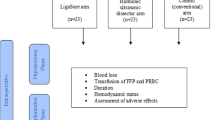Abstract
Blood loss, a well-known risk factor for morbidity and mortality during liver resection, occurs during parenchymal transection, so many approaches and devices have been developed to limit bleeding. Surgical technique is an important factor in preventing intraoperative and postoperative complications. The aim of the present study was to determine whether the bipolar vessel sealing device allows a safe and careful liver transection, achieving a satisfactory hemostasis thus reducing blood loss and related complications.
A total of 30 consecutive patients (18 male, 12 female with a mean age of 63 years) underwent major and minor hepatic resection in which the bipolar vessel sealing device was used without routine inflow occlusion. A crush technique followed by energy application was used to perform the parenchymal transection. No other devices were applied to achieve hemostasis. The bipolar vessel sealing device was effective in 27 cases of hepatic resection. It failed to achieve hemostasis in three patients, all of whom had a cirrhotic liver. Median blood loss was 250 ml (range: 100-1600 ml), and intraoperative blood transfusions were required in five patients (17%). Mean operative time was 200 minutes (range: 140-360 minutes). There was no clinical evidence of postoperative hemorrhage, bile leak, or intraabdorninal abscess.
The postoperative complication rate was 17%. The bipolar vessel sealing device is a useful tool in standard liver resection in patients with a normal liver parenchyma, but its use should be avoided in cirrhotic livers.

Similar content being viewed by others
References
M Rees G Plant J Wells et al. (1996) ArticleTitleOne hundred and fifty hepatic resections: evolution of a technique towards bloodless surgery Br. J. Surg. 83 1526–1529
R Doci L Gennari P Bignami et al. (1995) ArticleTitleMorbidity and mortality after hepatic resection of metastases from colorectal cancer Br. L. Surg. 82 377–381
J Belghiti K Hiramatsu S Benoist et al. (2000) ArticleTitleSeven hundred hepatectomies in the 1990s: an update to evaluate the actual risk of liver resection J. Am. Coll. Surg. 191 38–46
G Gozetti A Mazziotti L Grazi et al. (1995) ArticleTitleLiver resection without blood transfusion Br. L. Surg. 82 1105–1110
JD Cunningham Y Fong C Shriver et al. (1994) ArticleTitleOne hundred consecutive hepatic resections: blood loss, transfusion and operative technique Arch. Surg. 129 1050–1056
WR Jarnagin M Gonen Y Fong et al. (2002) ArticleTitleImprovement in perioperative outcome after hepatic resection: analysis of 1803 consecutive cases over the past decade Ann. Surg. 236 397–406
G Navarra D Spalding D Zacharoulis et al. (2002) ArticleTitleBloodless hepatectomy technique HPB Surg. 4 95–97
G Torzilli M Makuuchi Y Midorikawa et al. (2001) ArticleTitleLiver resection without total vascular exclusion: hazardous or beneficial? An analysis of our experience Ann. Surg. 233 167–175
JA Melendez V Arslan ME Fischer et al. (1998) ArticleTitlePerioperative outcomes of major hepatic resections under low central venous pressure anesthesia: blood loss, blood transfusion and the risk of perioperative renal dysfunction J. Am. Coll. Surg. 187 620–625
G Grazi A Mazziotti E Jovine et al. (1997) ArticleTitleTotal vascular exclusion of the liver during hepatic surgery: selective use, estensive use or abuse? Arch. Surg. 132 1104–1109
J Belghiti R Noun R Malafosse et al. (1999) ArticleTitleContinuous versus intermittent portal triad clamping for liver resection: a controlled study Ann. Surg. 229 369–375
PA Clavien S Yadav D Sindram et al. (2000) ArticleTitleProtective effects of ischemic preconditioning for liver resection performed under inflow occlusion in humans Ann. Surg. 232 155–162 Occurrence Handle10.1097/00000658-200008000-00001
KG Tranberg P Rigotti KA Brackett et al. (1998) ArticleTitleLiver resection: a comparison using ND-Yag laser, an ultrasonic surgical aspirator, or blunt dissection Am. J. Surg. 158 368–373
F Romano R Caprotti C Franciosi et al. (2002) ArticleTitleLaparoscopic splenectomy using Ligasure. A preliminary experience Surg. Endosc. 16 1608–1611
InstitutionalAuthorNameThe Brisbane Terminology of Liver Anatomy and Resections. (2000) ArticleTitle. HPB. Surg. 2 333–339
K Takenaka N Kawahara K Yamamoto et al. (1996) ArticleTitleResults of 280 liver resection for hepatocellular carcinoma Arch. Surg. 131 71–76
PJ Allen WR Jarnagin (2003) ArticleTitleCurrent status of hepatic resections Adv. Surg. 37 29–49
AA Parikh B Gentner TT Wu et al. (2003) ArticleTitlePerioperative complications in patients undergoing major liver resection with or without neoadjuvant chemotherapy J. Gastrointest. Surg. 7 1034–1044
G Nash W Walles (2003) ArticleTitleInfluence of postoperative morbidity on long-term survival following liver resection for colorectal metastasis Br. J. Surg. 90 1131–1136
KR Stephenson SM Steinberg KS Hughes et al. (1988) ArticleTitlePerioperative blood transfusions are associated with decreased time to reccurrence and decreased survival after resection of colorectal liver metastases Ann. Surg. 208 679–687
M Makuuchi T Takayama P Gunven et al. (1989) ArticleTitleRestrictive versus liberal blood transfusion policy for hepatectomies in cirrhotic patients World. J. Surg. 13 644–648
PG Horgan (2001) ArticleTitleA novel technique for parenchymal division during hepatectomy Am. J. Surg. 181 236–237 Occurrence Handle10.1016/S0002-9610(01)00556-6
SM Strasberg JA Drebin D Linehan (2002) ArticleTitleUse of bipolar vessel-sealing device for parenchymal transection during liver surgery J. Gastrointest. Surg. 6 569–574
J Kim SA Ahmad AM Lowy et al. (2003) ArticleTitleIncreased biliary fistulas after liver resection with the harmonic scalpel Am. Surg. 69 815–819
JS Kennedy PL Shanahan KD Taylor et al. (1998) ArticleTitleHigh-burst strength, feed-back controlled bipolar vessel sealing Surg. Endosc. 12 876–878
TB Heniford BD Matthews RF Sing et al. (2001) ArticleTitleInitial results with an elecrothermal bipolar vessel sealer Surg. Endosc. 15 799–801
RP DeMatteo Y Fong WR Jarnagin et al. (2000) ArticleTitleRecent advances in hepatic resections Semin. Surg. Oncol. 19 200–207
G Nuzzo F Giuliante I Giovannini et al. (1996) ArticleTitleHepatic resection in normothermic ischemia Surgery 120 852–858
Author information
Authors and Affiliations
Corresponding author
Rights and permissions
About this article
Cite this article
Romano, F., Franciosi, C., Caprotti, R. et al. Hepatic Surgery Using the Ligasure Vessel Sealing System. World J. Surg. 29, 110–112 (2005). https://doi.org/10.1007/s00268-004-7541-y
Published:
Issue Date:
DOI: https://doi.org/10.1007/s00268-004-7541-y




